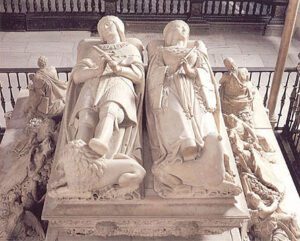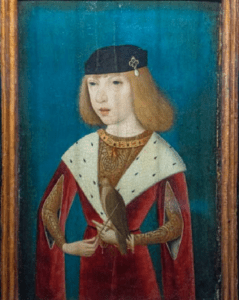Nicolas Roberto Robles
Badajoz, Spain
 |
| Figure 1. Tomb of Felipe I and Juana La Loca. Photo by Javi Guerra Hernando on Wikimedia. CC BY-SA 4.0. |
Philip of Habsburg was born in Bruges in 1478. He was the son of Maximilian I, the Holy Roman Emperor, and Mary of Burgundy, daughter of Charles the Bold, in a marriage that would ultimately extend control of the House of Austria over the Burgundian Netherlands. Philip was not yet four years old when his mother died, and upon her death, he inherited the Burgundian Netherlands in 1482, with his father acting as Regent until 1494.1,2
In 1496 Philip married Joanna of Castile (Catherine of Aragon’s older sister and the daughter of Ferdinand II of Aragon and Isabella I of Castile). In 1501, Philip and Joanna, coming through France to Castile to be sworn in as Princes of Asturias, stopped in Blois. There, King Louis XII of France received them, and upon seeing Philip exclaimed: “Here is a beautiful prince.” The phrase gave rise to the nickname by which Philip became known: “Philip the Handsome” (in Spanish, “Felipe el Hermoso”).
 |
| Figure 2. Portrait of Joan the Mad. Juan de Flandes. Kunsthistorisches Museum Wien, Bilddatenbank. Public domain. |
When Queen Isabella died in 1504, the crown of Castile passed on to Joanna, and her husband became king consort.3 Because Joanna was in the Netherlands at the time, Ferdinand, in accordance with Isabella’s will, acted as temporary regent. In early 1506 Joanna and Philip arrived in Spain. In Castile, Philip was backed by the nobility and negotiated an agreement with Ferdinand which left Philip in control. As Joanna’s mental state deteriorated, Philip assumed sole control.3,4
After the departure of Ferdinand, Philip remained in Valladolid, then left for Segovia and finally arrived in Burgos on September 7. On September 14, he had a hearty lunch with his prime minister, Don Juan Manuel, Lord of Belmonte, and then played ball with a group of gentlemen. It seems that, being overheated, he drank a glass of cold water and immediately felt unwell. On the 17th, he woke up with fever and malaise but said nothing and devoted himself to hunting all day. The next day, finding himself in the same state, he hid it all the same. The same thing happened the next day, and, only when overcome by an intense cold in the afternoon, he called his doctors. The disease progressed rapidly, Philip quickly lost consciousness, and the opinion that his death was inevitable immediately became widespread. He died on September 25, 1506.5
 |
| Figure 3. Portrait of Philip the Handsome at approximately 15 years. Master of the Magdalene Legend. Kasteel Huis Bergh. Public domain. |
Among contemporaries the speed of the process aroused suspicions of poisoning. Philip’s relations with his father-in-law, Ferdinand the Catholic, were not good, and, given his wife’s mental state, he was the leading candidate to be king of Castile. Moreover, the meal before he became ill was at the table of Don Juan Manuel, the most trusted person of Philip and not at all well-disposed to Ferdinand.
Also aware of the rumors, Philip’s doctor, Luigi Marliano of Milan, heard the rumors but considered them unsubstantiated; contemporary authors believe that the king died of a pestilential disease. The plague spread virulently through northern Spain in 1505, and three quarters of the inhabitants of Burgos fled their city. Moreover, it seems that the king abandoned Valladolid in 1506 because of the outbreak of the epidemic, which in that same year ravaged Lisbon. The day after the fever started, the king began to spit blood and felt pain in his side. On Monday, the disease worsened, presenting a strong inflammation in the throat, palate, and tongue. On Wednesday he went into a coma. The clinical reports agreed that plague was the cause of death.
The son of Philip the Handsome was Charles the Fifth, Emperor of the Holy German Empire and King of Spain.
Further reading
Juliana Menegakis. Queen Juana: The mad or the betrayed?
References
- “Philip I of Castile.” Wikipedia. https://en.wikipedia.org/wiki/Philip_I_of_Castile.
- “Felipe I.” Real Academia de la Historia. Accessed April 20, 2023. https://dbe.rah.es/biografias/10066/felipe-i.
- Encyclopaedia Britannica. “Philip I.” Last updated September 21, 2022. https://britannica.com/biography/Philip-I-king-of-Castile.
- Pérez-Bustamante R, and JM Calderón Ortega. Felipe I (1506) Palencia: La Olmeda, 1995.
- Doussinague, JM. Un proceso por envenenamiento: La muerte de Felipe El Hermoso. Madrid: Espasa-Calpe, 1947.
NICOLAS ROBERTO ROBLES is professor of Nephrology at the University of Extremadura (Badajoz) and member of the Academy of Medicine of Extremadura.
Spring 2023 | Sections | History Essays

Leave a Reply